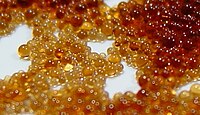
Photo from wikipedia
Bubbling carbon dioxide (CO2) into aqueous solutions of bile salts such as sodium deoxycholate caused a gelation of the solution, forming a hydrogel made of entirely natural biological molecules and… Click to show full abstract
Bubbling carbon dioxide (CO2) into aqueous solutions of bile salts such as sodium deoxycholate caused a gelation of the solution, forming a hydrogel made of entirely natural biological molecules and providing a convenient storage reservoir of CO2 in water. The carboxylate group of the bile salt becomes protonated in the aqueous solutions to make the bile acid only marginally soluble in water, which induces the formation of a supramolecular hydrogel with nanofibrous structures. Such hydrogels show convenient gel–sol transition by the desorption of CO2. The mechanical properties of the hydrogels may be varied by the amounts of CO2 in the media, reaching a peak value of the storage modulus of the hydrogel. Bubbling CO2 initially yielded a transparent hydrogel which upon continued purging became mechanically stronger and optically opaque. The bile salt aqueous solutions absorb CO2 effectively and may potentially serve as an alternative material for CO2 capture and storage.
Journal Title: ACS Sustainable Chemistry & Engineering
Year Published: 2019
Link to full text (if available)
Share on Social Media: Sign Up to like & get
recommendations!